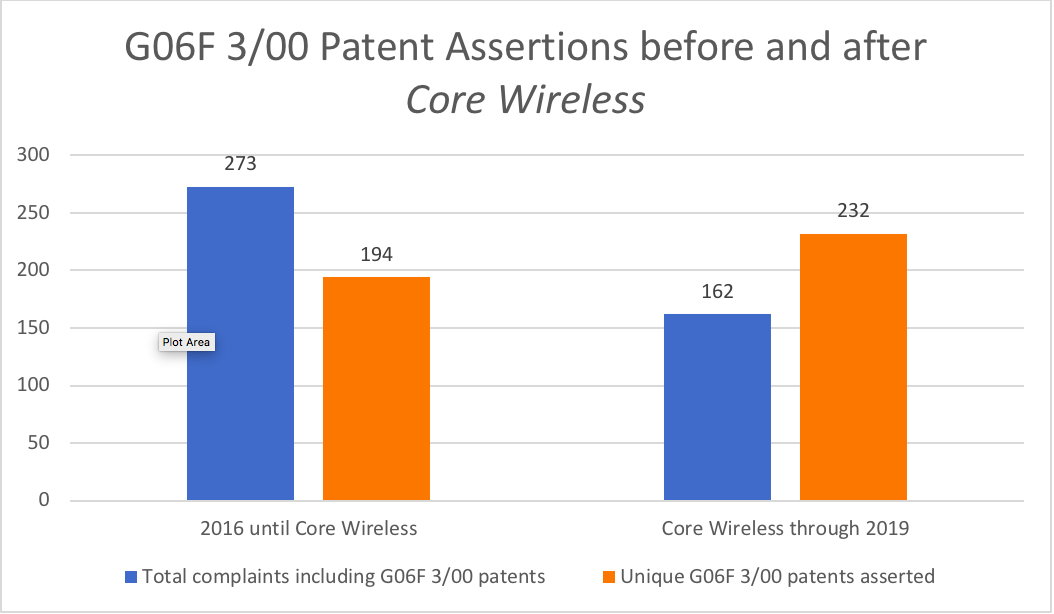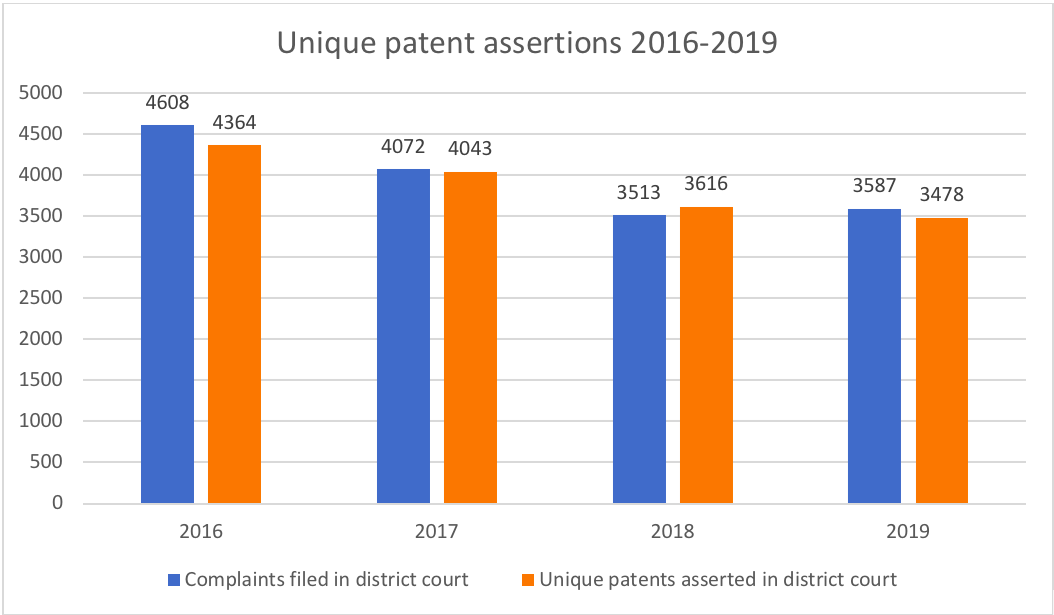A look at the recent data shows that the Federal Circuit’s Core Wireless decision has had a net positive effect for owners of graphical user interface patents.
 To many patent practitioners, the Federal Circuit’s decision in Core Wireless Licensing S.A.R.L. v. LG Electronics, Inc. was a watershed moment. In particular, this decision provided that claims directed to “display interfaces” that “improved” on existing interfaces were patent eligible under 35 U.S.C. § 101. In other words, Core Wireless decreased the chances of a court finding a graphical user interface (GUI) patent to be directed to ineligible subject matter and therefore invalid.
To many patent practitioners, the Federal Circuit’s decision in Core Wireless Licensing S.A.R.L. v. LG Electronics, Inc. was a watershed moment. In particular, this decision provided that claims directed to “display interfaces” that “improved” on existing interfaces were patent eligible under 35 U.S.C. § 101. In other words, Core Wireless decreased the chances of a court finding a graphical user interface (GUI) patent to be directed to ineligible subject matter and therefore invalid.
We don’t have to look far to see the impact that the nearly-three-year-old Core Wireless decision has had. Almost 100 district court decisions have cited the case since it came down in January of 2019, and nearly 30 inter partes review (IPR) proceedings filed after January of 2019 include citations of Core Wireless by practitioners, the Board, or both.
Delving into the Data
However, a question remains whether eligibility decisions like Core Wireless influence enforcement activities by patent holders. Indeed, the effects can be difficult to parse because eligibility decisions are contextualized by the claims that were asserted. Accordingly, in order to investigate whether Core Wireless has had an influence on patent assertions, we can consider complaints that asserted patents in the same Cooperative Patent Classification (CPC) group as the two patents asserted in Core Wireless. In particular, both asserted patents in Core Wireless were classified in G06F 3/00. This group includes “output arrangements for transferring data from processing unit to output unit, e.g. interface arrangements.” Although a manual assessment of claims could weed out any G06F 3/00 patents that are directed to hardware rather than GUIs, this analysis is sufficient to identify a rough trend. Thus, without relying on a manual review of the claims in each asserted patent before and after Core Wireless, we can form a general idea of the effect Core Wireless had on patent enforcement actions.
The number of unique G06F 3/00 patents asserted in district court or at the International Trade Commission (ITC) is shown below for 2016 through 2019.

As is evident, the number of unique G06F 3/00 patents asserted increased in 2018 and 2019 as compared with 2016 and 2017. (Note: 11 of the unique G06F 3/00 patents asserted in 2018 were included in complaints filed before the Federal Circuit’s decision in Core Wireless. This does not affect the conclusion that the number of unique G06F 3/00 patents asserted increased after Core Wireless.) Moreover, this increase persisted even as the total number of complaints including G06F 3/00 patents decreased, which was likely due to changes in the average number of patents asserted per complaint.
The increase in the number of unique G06F 3/00 patents asserted in district court or at the ITC after Core Wireless is clearer in the chart below.

Thus, the number of unique G06F 3/00 patents asserted in the 23 months after Core Wireless was decided was higher than the number of unique G06F 3/00 patents asserted in the 25 months prior. In fact, there was a nearly 20% increase in the number of unique G06F 3/00 patents asserted after Core Wireless was decided.
This trend becomes even more stark as compared with the overall trend of patent assertions from 2016 through 2019. The following chart based on Patexia’s data shows the total number of unique patents asserted in district court for 2016-2019.

Accordingly, across the same time frame in which the number of unique G06F 3/00 patents asserted increased by around 20%, the total number of unique patents asserted decreased by around 10-20%.
A Boon for Patent Owners
Patent owners are not asserting in a vacuum. It’s only logical to assume that patent owners and their counsel are watching subject-matter eligibility trends and, at least in part, making assertion decisions under the influence of those trends. The data in this article confirm that Core Wireless does appear to have had a positive impact on patent owners seeking to assert their GUI patents.

![[IPWatchdog Logo]](https://ipwatchdog.com/wp-content/themes/IPWatchdog%20-%202023/assets/images/temp/logo-small@2x.png)

![[Advertisement]](https://ipwatchdog.com/wp-content/uploads/2024/04/UnitedLex-May-2-2024-sidebar-700x500-1.jpg)
![[Advertisement]](https://ipwatchdog.com/wp-content/uploads/2024/04/Artificial-Intelligence-2024-REPLAY-sidebar-700x500-corrected.jpg)
![[Advertisement]](https://ipwatchdog.com/wp-content/uploads/2024/04/Patent-Litigation-Masters-2024-sidebar-700x500-1.jpg)

![[Advertisement]](https://ipwatchdog.com/wp-content/uploads/2021/12/WEBINAR-336-x-280-px.png)
![[Advertisement]](https://ipwatchdog.com/wp-content/uploads/2021/12/2021-Patent-Practice-on-Demand-recorded-Feb-2021-336-x-280.jpg)
![[Advertisement]](https://ipwatchdog.com/wp-content/uploads/2021/12/Ad-4-The-Invent-Patent-System™.png)






Join the Discussion
No comments yet.